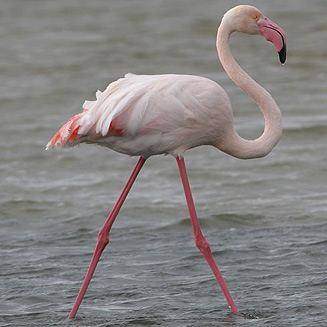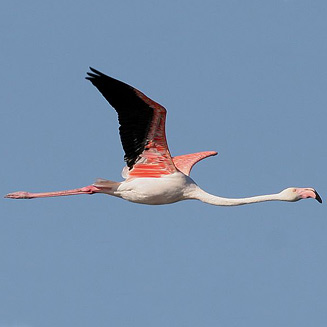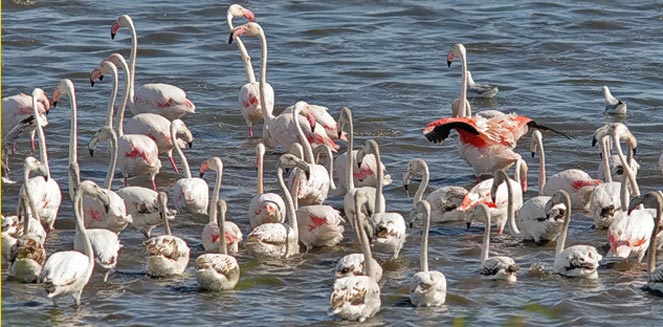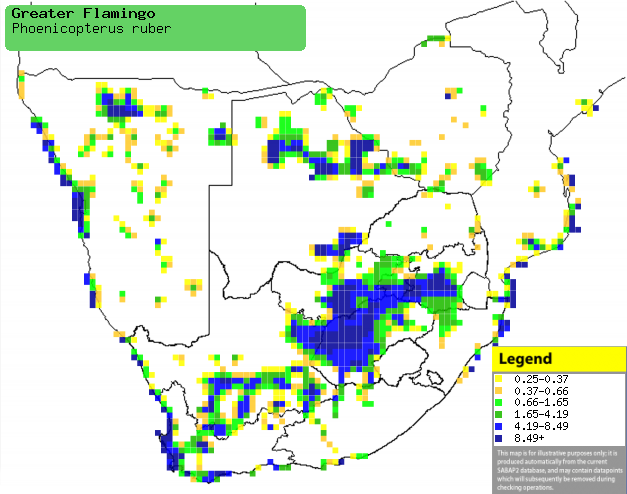|
Phoenicopterus ruber (Greater
flamingo)
Grootflamink [Afrikaans]; uKholwase, uNondwebu [Zulu];
Flamingo [Dutch]; Flamant rose [French]; Flamingo [German]; Flamingo-comum
[Portuguese]
Life
> Eukaryotes >
Opisthokonta
> Metazoa (animals) >
Bilateria >
Deuterostomia > Chordata >
Craniata > Vertebrata (vertebrates) > Gnathostomata (jawed
vertebrates) > Teleostomi (teleost fish) > Osteichthyes (bony fish) > Class:
Sarcopterygii (lobe-finned
fish) > Stegocephalia (terrestrial
vertebrates) > Tetrapoda
(four-legged vertebrates) > Reptiliomorpha > Amniota >
Reptilia (reptiles) >
Romeriida > Diapsida > Archosauromorpha > Archosauria >
Dinosauria
(dinosaurs) > Saurischia > Theropoda (bipedal predatory dinosaurs) >
Coelurosauria > Maniraptora > Aves
(birds) > Order: Ciconiiformes
> Family: Phoenicopteridae
 |
 |
|
Greater flamingo, Strandfontein Sewage Works,
South Africa. [photo Trevor Hardaker ©] |
Greater flamingo, Strandfontein Sewage Works,
South Africa. [photo Trevor Hardaker ©] |
 |
|
Greater flamingos. [photo
Jeff Poklen
©] |
Distribution and habitat
Occurs from Pakistan and India to southern Europe, south
through the Arabian Peninsula and Iran to sub-Saharan Africa.
In southern Africa, it is locally abundant along the coast of Mozambique, in southern Zimbabwe, central and southern Botswana,
northern and western Namibia and central and
south-western South Africa. It generally prefers coastal mudflats, inland dams,
sewage treatment works, small temporary pans and river mouths, while it
exclusively breeds at recently flooded, large eutrophic shallow salt pans.
|
 |
|
Distribution of Greater flamingo in southern Africa,
based on statistical smoothing of the records from first SA Bird Atlas
Project (©
Animal Demography unit, University of
Cape Town; smoothing by Birgit Erni and Francesca Little). Colours range
from dark blue (most common) through to yellow (least common).
See here for the latest distribution
from the SABAP2. |
Movements and migrations
Little known, although it is thought that it
moves at night when heavy rainfall causes the pan to flood. If this
happens in Namibia, it tends to head north before heading inland to
the Etosha Pan. There is also evidence to suggest that it migrates
from East Africa to southern Africa, especially to the Sua Pan of
Botswana.
Food
It mainly eats small invertebrates, such as brine shrimps (Artemia),
brine flies (Ephydra), molluscs and diatoms, foraging by holding its bill
upside down in waist-high water. Its large tongue pumps water in and out, while
small filaments at the edge of its bill filter out food.
Breeding
- Monogamous, although it changes its mate each breeding season, breeding in
colonies with hundreds to thousands of nests. Hundreds of them perform a spectacular
courtship display in which they march in the same direction while flapping
their wings and outstretching their necks.
- The nest is built mainly by the male at first, while the female starts
to assist him in the run up to the egg-laying season. It consists of a mound of
dry or damp mud, with a shallow depression in the centre, about 15-45 cm
high. It is often built on top of an older nest.
- Egg-laying season starts in November, peaking from January-February,
although egg-laying may continue in waves until August.
- It lays a single egg, rarely two, which is incubated by both sexes for
roughly 27-31 days.
- The chicks are brooded for the first 3-4 days of their lives, leaving
the nest at 5-10 days old to join a crèche along with other
Lesser and Greater flamingos of
similar age. It is fed by both parents with a glandular secretion, taking
its first flight at about 75-80 days old.
Threats
Not threatened globally, although Near-threatened in
South Africa and Vulnerable in Namibia, largely due to lowering water
tables at major breeding sites and collision with powerlines.
References
-
Hockey PAR, Dean WRJ and Ryan PG 2005. Roberts
- Birds of southern Africa, VIIth ed. The Trustees of the John Voelcker
Bird Book Fund, Cape Town.
|
